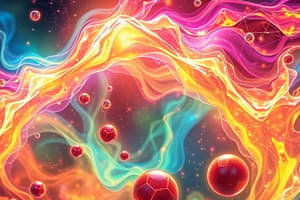Podcast
Questions and Answers
What are the properties of semimetals or metalloids?
What are the properties of semimetals or metalloids?
Intermediate between metals and nonmetals
What happens to semimetals when doped with other materials?
What happens to semimetals when doped with other materials?
They become conductors
How are salts formed?
How are salts formed?
When metals combine with nonmetals or acids
What are the applications of inorganic chemistry in agriculture?
What are the applications of inorganic chemistry in agriculture?
Name one application of inorganic chemistry in energy production.
Name one application of inorganic chemistry in energy production.
Study Notes
The Wonders of Inorganic Chemistry: Unraveling the Mysteries of Non-Organic Elements
Inorganic chemistry, a subfield of chemistry that focuses on non-organic elements and compounds, plays a crucial role in our daily lives. This branch of chemistry explores the physical and chemical properties of inorganic compounds, their reactions, and the relationships between their structures and properties. Inorganic compounds are not derived from living organisms, unlike organic compounds, which are made up of carbon, hydrogen, oxygen, nitrogen, phosphorus, and sulfur. Inorganic chemistry has a vast scope, encompassing various topics such as minerals, rocks, and the Earth's crust, as well as the study of nonmetals, metals, semimetals, and their compounds.
The Building Blocks of Inorganic Chemistry
Inorganic chemistry is primarily concerned with the study of elements and their compounds, which can be further classified into four main categories:
-
Metals: These are usually solids, except for mercury, which is a liquid at room temperature and copper, which is also a liquid at high temperatures. Metals are generally good conductors of heat and electricity, have a shiny appearance, and are malleable and ductile.
-
Nonmetals: Nonmetals can be solids, liquids, or gases, and they usually do not have the shiny appearance or good conductivity of metals. They form a wide range of compounds, including ions, molecules, and network solids.
-
Semimetals or Metalloids: These elements have properties that are intermediate between metals and nonmetals. Semimetals are generally inert and nonconducting, but they become conductors when doped with other materials.
-
Salts: Salts are inorganic compounds that can be found in nature or synthesized in the lab. They are formed when metals combine with nonmetals or acids.
Inorganic Chemistry Applications
Inorganic chemistry has numerous applications in various fields, including:
-
Mineral extraction: Inorganic compounds are used to extract minerals and metals from ores.
-
Manufacturing: Inorganic compounds are used in the production of ceramics, glass, pigments, dyes, paints, and other materials.
-
Medicine: Inorganic compounds are used in the production of drugs, vaccines, and medical devices.
-
Agriculture: Inorganic compounds are used as fertilizers, pesticides, and herbicides.
-
Energy: Inorganic compounds are used in the production of batteries, solar cells, and catalysts for fuel cells.
Conclusion
Inorganic chemistry is a fascinating field that explores the properties, reactions, and applications of non-organic elements and compounds. From the study of metals, nonmetals, semimetals, and salts to its numerous applications in various industries, inorganic chemistry plays a crucial role in our daily lives. As technology continues to advance, the importance of inorganic chemistry in solving real-world problems and developing new technologies will only grow.
Studying That Suits You
Use AI to generate personalized quizzes and flashcards to suit your learning preferences.
Description
Test your knowledge about inorganic chemistry and its significance in various industries. Explore the properties, reactions, and applications of non-organic elements and compounds.




